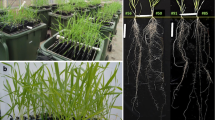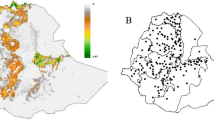Abstract
Background and aims
Intra-specific variation in root system architecture and consequent efficiency of resource capture by major crops has received recent attention. The aim of this study was to assess variability in a number of root traits among wild genotypes of narrow-leafed lupin (Lupinus angustifolius L.), to provide a basis for modelling of root structure.
Methods
A subset of 111 genotypes of L. angustifolius was selected from a large germplasm pool based on similarity matrices calculated using Diversity Array Technology markers. Plants were grown for 6 weeks in the established semi-hydroponic phenotyping systems to measure the fine-scale features of the root systems.
Results
Root morphology of wild L. angustifolius was primarily dominated by the taproot and first-order branches, with the presence of densely or sparsely distributed second-order branches in the late growth stage. Large variation in most root traits was identified among the tested genotypes. Total root length, branch length and branch number in the entire root system and in the upper roots were the most varied traits (coefficient of variation CV >0.50). Over 94% of the root system architectural variation determined from the principal components analysis was captured by six components (eigenvalue >1). Five relatively homogeneous groups of genotypes with distinguished patterns of root architecture were separated by k-means clustering analysis.
Conclusions
Variability in the fine-scale features of root systems such as branching behaviour and taproot growth rates provides a basis for modelling root system structure, which is a promising path for selecting desirable root traits in breeding and domestication of wild and exotic resources of L. angustifolius for stressful or poor soil environments.





Similar content being viewed by others
References
Ao J, Fu AJ, Tian J, Yan X, Liao H (2010) Genetic variability for root morph-architecture traits and root growth dynamics as related to phosphorus efficiency in soybean. Funct Plant Biol 37:304–312
Berger JD, Adhikari KN, Wilkinson D, Buirchell BJ, Sweetingham MW (2008) Ecogeography of the Old World lupins 1 ecotypic variation in yellow lupin (Lupinus luteus L). Aust J Agric Res 59:691–701
Bishop A, Delane R, Hamblin J (1986) Root characteristics in branching and reduced branching lupins. In: Proceedings of 4th International Lupin Conference, 15–22 August, 1986. Geraldton, Western Australian. International Lupin Association, Canterbury, New Zealand, pp. 313
Buirchell BJ (2008) Narrow-leafed lupin breeding in Australia–Where to from here? In: Palta JA, Berger JB (eds) Lupins for Health and Wealth–Proceedings of the 12th International Lupin Conference. 14–18 Sept. 2008, Fremantle, Western Australia. International Lupin Association, Canterbury, pp 226–230
Byrne F, Robertson MJ, Bathgate A, Hoque Z (2010) Factors influencing potential scale of adoption of a perennial pasture in a mixed crop-livestock farming system. Agric Syst 103:453–462
Casson SA, Lindsey K (2003) Genes and signalling in root development. New Phytol 158:11–38
Chen YL, Dunbabin VM, Diggle AJ, Siddique KHM, Rengel Z (2011a) Development of a novel semi-hydroponic phenotyping system for studying root architecture. Funct Plant Biol 38:355–363
Chen YL, Dunbabin VM, Postma J, Diggle AJ, Lynch JP, Siddique KHM, Rengel Z (2011b) Phenotypic variation and modelling of wild Lupinus angustifolius germplasm. Plant Soil 348:345–364. doi:10.1007/s11104-011-0939-z
Clements JC, Cowling WA (1994) Patterns of morphological diversity in relation to geographical origins of wild Lupinus angustifolius from the Aegean region. Gen Resour Crop Evol 41:109–122
Clements JC, White PF, Buirchell BJ (1993) The root morphology of Lupinus angustifolius in relation to other Lupinus species. Aust J Agric Res 44:1367–1375
Comas LH, Eissenstat DE (2009) Patterns in root trait variation among 25 co-existing North American forest species. New Phytol 182:919–928
de Dorlodot S, Forster B, Pagès L, Price A, Tuberosa R, Draye X (2007) Root system architecture, opportunities and constraints for genetic improvement of crops. Trends Plant Sci 12:474–481
Diggle AJ (1988) ROOTMAP—a model in three-dimensional co-ordinates of the growth and structure of fibrous root systems. Plant Soil 105:169–178
Dracup M, Thomson B (2000) Narrow-leafed lupins with restricted branching. Ann Bot 85:29–35
Dunbabin VM (2007) Simulating the role of rooting traits in crop–weed competition. Field Crop Res 104:44–51
Dunbabin VM, Rengel Z, Diggle A (2001) Lupinus angustifolius has a plastic uptake response to heterogeneously supplied nitrate while Lupinus pilosus does not. Aust J Agric Res 52:505–512
Dunbabin VM, Diggle AJ, Rengel Z, van Hugten R (2002) Modelling the interactions between water and nutrient uptake and root growth. Plant Soil 239:19–38
Dunbabin VM, Diggle AJ, Rengel Z (2003) Is there an optimal root architecture for nitrate capture in leaching environments? Plant Cell Environ 26:835–844
Eissenstat DM, Wells CE, Yanai RD, Whitbeck JL (2000) Building roots in a changing environment, implications for root longevity. New Phytol 147:33–42
Giuliani S, Sanguineti MC, Tuberosa R, Bellotti M, Salvi S, Laudi P (2005) Root-ABA1, a major constitutive QTL, affects maize root architecture and leaf ABA concentration at different water regimes. J Exp Bot 56:3061–3070
Gladstones JS (1974) Lupins of the Mediterranean region and Africa. West Aust Depart Agr Tech Bull 26:1–48
Gregory PJ, Bengough AG, Grinev D, Schmidt S, Thomas WTB, Wojciechowski T, Young IM (2009) Root phenomics of crops, opportunities and challenges. Funct Plant Biol 36:922–929
Hammer GL, Dong Z, McLean G, Doherty A, Messina C, Schussler J, Zinselmeier C, Paszkiewicz S, Cooper M (2009) Can changes in canopy and/or root system architecture explain historical maize yield trends in the US corn belt? Crop Sci 49:299–312
Hodge A (2010) Roots, the acquisition of water and nutrients from the heterogeneous soil environment. Prog Bot 71:307–337
Hodge A, Berta G, Doussan C, Merchan F, Crespi M (2009) Plant root growth, architecture and function. Plant Soil 321:153–187
Horii H, Nemoto K, Miyamoto N, Harada J (2005) Quantitative trait loci for adventitious and lateral roots in rice. Plant Breed 125:198–200
Jolliffe IT (2002) Principal component analysis, 2nd edn. Springer, New York
López-Bucio J, Cruz-Ramírez A, Herrera-Estrella L (2003) The role of nutrient availability in regulating root architecture. Curr Opin Plant Biol 6:280–287
Lynch J (1995) Root architecture and plant productivity. Plant Physiol 109:7–13
Lynch JP, Brown KM (2001) Topsoil foraging—an architectural adaptation of plants to low phosphorus availability. Plant Soil 237:225–237
Lynch J, Nielsen K, Davis R, Jablokow A (1997) Simroot, modeling and visualization of botanical root systems. Plant Soil 188:139–151
Manschadi AM, Hammer GL, Christopher JT, de Voil P (2008) Genotypic variation in seedling root architectural traits and implications for drought adaptation in wheat (Triticum aestivum L.). Plant Soil 303:115–129
Manske GGB, Ortiz-Monasterio JI, Ginkel MV, González RM, Rajaram S, Molina E, Vlek PLG (2000) Traits associated with improved P-uptake efficiency in CIMMYT’s semi-dwarf spring bread wheat grown on an acid Andisol in Mexico. Plant Soil 221:189–204
Merrill SD, Tanaka DL, Hanson JD (2002) Root length growth of eight crop species in Haplustoll soils. Soil Sci Soc Am J 63:913–923
Nelson MN, Moolhuijzen PM, Boersma JG, Chudy M, Lesniewska K, Bellgard M, Oliver RP, Swiecicki W, Wolko B, Cowling WA, Ellwood SR (2010) Aligning a new reference genetic map of Lupinus angustifolius with the genome sequence of the model legume, Lotus japonicus. DNA Res 17:73–83
Nibau C, Gibbs DJ, Coates JC (2008) Branching out in new directions, the control of root architecture by lateral root formation. New Phytol 179:595–614
Nielsen KL, Lynch JP, Weiss HN (1997) Fractal geometry of bean root systems, correlations between spatial and fractal dimension. Am J Bot 84:26–33
Nielsen KL, Eshel A, Lynch JP (2001) The effect of phosphorus availability on the carbon economy of contrasting common bean (Phaseolus vulgaris L.) genotypes. J Exp Biol 52:329–339
Ostonen I, Püttsepp Ü, Biel C, Alberton O, Bakker MR, Lõhmus K, Majdi H, Metcalfe D, Olsthoorn AFM, Pronk A, Vanguelova E, Weih M, Brunner I (2007) Specific root length as an indicator of environmental change. Plant Biosystems 141:426–442
Palta JA, Berger JD, Ludwig C (2008) The growth and yield of narrow leafed lupin, myths and realities. In: Palta JA, Berger JB (eds) Lupins for Health and Wealth - Proceedings of the 12th International Lupin Conference, 14–18 September, 2008, Fremantle, Western Australia. International Lupin Association, Canterbury, pp 20–25
Probert ME, Dimes JP, Keating BA, Dalal RC, Strong WM (1998) APSIM’s water and nitrogen modules and simulation of the dynamics of water and nitrogen in fallow systems. Agr Syst 56:1–28
Rengel Z, Damon PM (2008) Crops and genotypes differ in efficiency of potassium uptake and use. Physiol Plant 133:624–636
Römer W, Kang DK, Egle K, Gerke J, Keller H (2000) The acquisition of cadmium by Lupinus albus L., Lupinus angustifolius L., and Lolium multiflorum Lam. J Plant Nutr Soil Sc 163:623–628
Rose CW, Chichester FW, Williams JR, Ritchie JT (1982) A contribution to simplified models of field solute transport. J Environ Qual 11:146–150
Rose TJ, Rengel Z, Ma Q, Bowden JW (2009) Crop species differ in root plasticity response to localised P supply. J Plant Nutr Soil Sc 172:360–368
Sergeeva LI, Keurentjes JJB, Bentsink L, Vonk J, van der Plas LHW, Koornneef M, Vreugdenhil D (2006) Vacuolar invertase regulates elongation of Arabidopsis thaliana roots as revealed by QTL and mutant analysis. Proc Natl Acad Sc U S A 103:2994–2999
Steele KA, Virk DS, Kumar R, Prasad SC, Witcombe JR (2007) Field evaluation of upland rice lines selected for QTLs controlling root traits. Field Crop Res 101:180–186
Tabachnik BG, Fidell LS (1996) Using multivariate statistics. Harper Collins, New York
Tang C, Robson AD (1998) Correlation between soil pH of collection site and the tolerance of wild genotypes of Lupinus angustifolius L. to neutral pH. Aust J Exp Agric 38:355–362
Walk TC, Jaramillo P, Lynch JP (2006) Architectural tradeoffs between adventitious and basal roots for phosphorus acquisition. Plant Soil 279:347–366
Weih M, Rönnberg-Wästljung A, Glynn C (2006) Genetic basis of phenotypic correlations among growth traits in hybrid willow (Salix dasyclados × S. viminalis) grown under two water regimes. New Phytol 170:467–477
Yuan H, Yan G, Siddique KHM, Yang H (2005) RAMP based fingerprinting and assessment of relationships among Australian narrow-leafed lupin (Lupinus angustifolius L.) cultivars. Aust J Agric Res 56:1339–1346
Zhu J, Zhang C, Lynch JP (2010) The utility of phenotypic plasticity of root hair length for phosphorus acquisition. Funct Plant Biol 37:313–322
Acknowledgements
The Australian Research Council (ARC) provided funding for this research. We acknowledge J. Clements from The University of Western Australia, and the Department of Agriculture and Food of Western Australia, for providing lupin seed and advice for this work. We are grateful to J.P. Lynch of Pennsylvania State University for critical comments on a draft, and M. Renton for an initial discussion on the use of R program.
Author information
Authors and Affiliations
Corresponding authors
Additional information
Responsible Editor: Alain Pierret.
Rights and permissions
About this article
Cite this article
Chen, Y.L., Dunbabin, V.M., Diggle, A.J. et al. Assessing variability in root traits of wild Lupinus angustifolius germplasm: basis for modelling root system structure. Plant Soil 354, 141–155 (2012). https://doi.org/10.1007/s11104-011-1050-1
Received:
Accepted:
Published:
Issue Date:
DOI: https://doi.org/10.1007/s11104-011-1050-1




